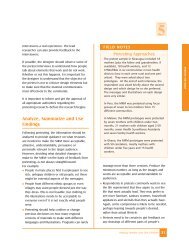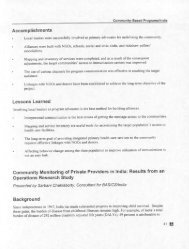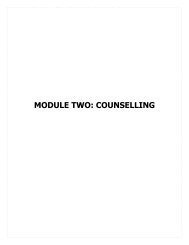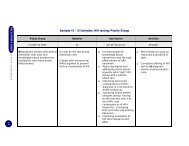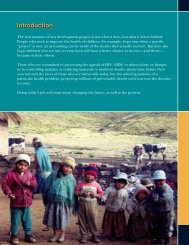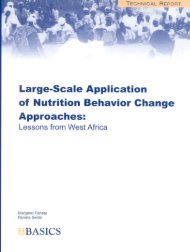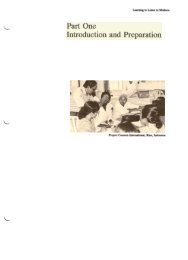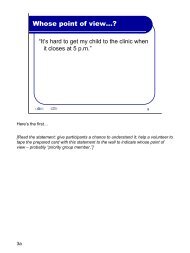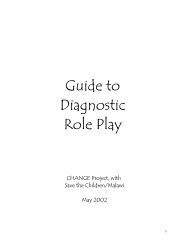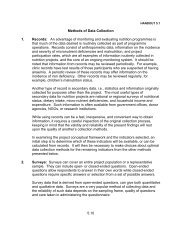Participatory Techniques For Community-Based Program ...
Participatory Techniques For Community-Based Program ...
Participatory Techniques For Community-Based Program ...
You also want an ePaper? Increase the reach of your titles
YUMPU automatically turns print PDFs into web optimized ePapers that Google loves.
I. Key Points from the Training Sessions<br />
1
SESSION 1<br />
Course Overview and Ice Breaker<br />
Session Objectives<br />
By the end of this session, you will...<br />
U...appreciate the variety of work done by your fellow<br />
participants<br />
U...have a better understanding of the way you currently<br />
develop programmes<br />
U...understand the course objectives and agenda<br />
U...reconcile your personal expectations with the course objectives<br />
CONTEXT: This first session is designed to introduce you to the other participants<br />
and to the course. In addition to receiving the workshop agenda and objectives, you<br />
will be given the opportunity to express your own expectations. The introductory case<br />
study serves two purposes: 1) It provides the trainers with a baseline for assessing<br />
the success of the training; and 2) It orients you to the types of things that you will<br />
be learning in the course.<br />
Course Objectives<br />
By the end of this course, you will be able to...<br />
UUnderstand the history and foundations of participatory learning and action (PLA)<br />
approaches<br />
UIdentify and implement the different steps of the participatory programme development<br />
(PPD) process<br />
UPractice the behaviours and attitudes which are necessary for the successful<br />
implementation of PLA<br />
UFacilitate the use of various PLA techniques<br />
2
SESSION 2<br />
Introduction to <strong>Participatory</strong> <strong>Program</strong>me Development (PPD)<br />
Session Objectives<br />
By the end of this session, you will...<br />
U...Reach a consensus on the meaning of “participation”<br />
U...Be able to define <strong>Participatory</strong> <strong>Program</strong>me Development<br />
(PPD) and the word “community”<br />
U...Understand the basic concepts of PPD<br />
U...Understand the history and foundations of participatory learning and<br />
action<br />
CONTEXT: The main goal of this session is for participants to come to a consensus<br />
on two of the main concepts that are the basis of the training: participation and<br />
community. In addition, you will learn about the history and theory of <strong>Participatory</strong><br />
Learning and Action (PLA) and watch a video to illustrate these basic concepts. This<br />
session builds the foundation necessary for learning about the specific steps of the<br />
<strong>Participatory</strong> <strong>Program</strong>me Development Process and specific PLA techniques.<br />
Participation can take many forms within development programmes, and some types of<br />
participation are more “participatory” than others. A participatory continuum is on the<br />
following page 1 , laying out different forms of participation, from the least participatory to<br />
the most participatory. Which type of participation best matches your drawing of<br />
participation?<br />
The goal of PPD is to enable communities to engage in collective action, which is the most<br />
participatory form of participation.<br />
1 Adapted from Pretty (1995) in Cornwall, A. 1996. Towards <strong>Participatory</strong> Practice: <strong>Participatory</strong><br />
Rural Appraisal (PRA) and the <strong>Participatory</strong> Process. In <strong>Participatory</strong> Research in Health: Issues and<br />
Experiences. de Koning, K. and M. Martin, eds. p. 96. London: Zed Books.<br />
3
THE PARTICIPATORY CONTINUUM<br />
Mode of Participation Involvement of Local People Relationship of Research and<br />
Action to Local People<br />
Co-option Token representatives are chosen, ON<br />
but have no real input or power.<br />
Compliance Tasks are assigned with incentives; FOR<br />
outsiders decide agenda and direct the process.<br />
Consultation Local opinions are asked; outsiders analyse FOR/ WITH<br />
and decide on a course of action.<br />
Mode of Participation Involvement of Local People Relationship of Research and<br />
Action to Local People<br />
Cooperation Local people work together with outsiders to WITH<br />
determine priorities; responsibility remains with<br />
outsiders for directing the process.<br />
Co-learning Local people and outsiders share their knowledge WITH/ BY<br />
to create new understanding and work together<br />
plans, to form action with outsider facilitation.<br />
Collective action Local people set their own agenda and mobilize to, BY<br />
carry it out in the absence of outside initiators<br />
and facilitators.<br />
Definition of <strong>Participatory</strong> <strong>Program</strong>me Development<br />
<strong>Participatory</strong> <strong>Program</strong>me Development (PPD) is the process of working in partnership<br />
with communities to develop feasible, desirable and<br />
sustainable programmess.<br />
PPD uses an approach known as <strong>Participatory</strong> Learning and Action (PLA). PLA is a process<br />
that enables community members to 1) analyse their needs; 2) identify possible solutions<br />
to meet those needs; and 3) develop, implement, and evaluate a plan of action. The<br />
background and foundations of PLA are discussed in greater detail below.<br />
4
Focussed or Unfocussed PPD?<br />
PPD can be either focussed on a specific sector or issue, or it can be “open”, meaning that<br />
the community is free to implement projects addressing any issue that it chooses. Many<br />
sponsoring agencies (SAs) are not able to do open PPD, however, because they receive<br />
money from donors to do work on specific issues. Although this situation may not be ideal,<br />
because it limits the community’s freedom to decide which issues to address, it is<br />
important to recognize this reality and work within it.<br />
If the sponsoring agencies faces these types of constraints, they have one of two options:<br />
1) They can be direct with the community before the PPD process begins, and tell them<br />
that it will focus on a specific sector or issue (e.g., health or education); or<br />
2) They can conduct the PPD in an “open” fashion, and hope that the community identifies<br />
their issue as one of their priorities. If this does not happen, the SA should be willing to<br />
link the communities with other SAs who could help them address their priority issues.<br />
Definition of “<strong>Community</strong>”<br />
Before learning the principles and techniques of PPD, it is helpful to define the word<br />
“community”, since the community participation is the heart of PPD. Webster’s II New<br />
Riverside Dictionary gives two definitions for the word “community”:<br />
A group of people residing in the same region and under the same government<br />
and<br />
A class or group with common interests<br />
In rural areas, the first definition generally applies. In urban areas, the first definition<br />
could also apply (e.g., in a neighbourhood), but there are also many other types of<br />
communities that are not dependent on geography to define them as a community. <strong>For</strong><br />
example, urban residents may have little in common with their neighbours, but they may be<br />
linked to other urban dwellers through work, studies or common interests. Examples of<br />
urban communities include factory workers, commercial sex workers, members of social<br />
clubs and university students.<br />
Facilitating PLA with these “non-traditional” types of communities can pose special<br />
challenges, because the people may come together in one place only for a few hours each<br />
day (or even less frequently). Therefore, the scheduling of PLA activities may be more<br />
complex in urban areas than in rural areas.<br />
5
The PLA Team<br />
An ideal PLA team is composed of six to ten people, although this number is not fixed, and<br />
the team may be larger or smaller. It is also multidisciplinary, which means that the team<br />
normally has is a mix of different genders, disciplines and career statuses. In addition,<br />
there are often representatives of different groups or organisations, including the<br />
following:<br />
gThe agency sponsoring the PLA workshop<br />
gOther NGOs or development agencies that are working in sectors related to the<br />
PLA workshop (e.g., health, agriculture, education, environment)<br />
gLocal government representatives (e.g., extension officers, members of district<br />
development committees)<br />
g<strong>Community</strong> members (community link persons)<br />
Note that this team composition is not fixed; it is possible that not all of these groups will<br />
be represented, or that other groups not mentioned will be a part of the team. Every team<br />
will be different, depending on the community.<br />
Each team member has a well-defined role 2 . One person takes on the role of team leader,<br />
and the others act as both facilitators and note takers. The PLA team often divides up<br />
into pairs or groups of three in order to work with different community groups<br />
simultaneously.<br />
g<br />
The leader is in charge of making the initial contact with the community; serving as<br />
the primary link with village leaders; coordinating logistics of the field work;<br />
introducing the team to the community; supervising the work of other team<br />
members; ensuring that activities stay on schedule; moderating conflicts between<br />
team members; facilitating daily team meetings; overseeing the report writing and<br />
editing; distributing the final report; and making arrangements for follow-up after<br />
the workshop (by assuring that there are appropriate liaisons from the sponsoring<br />
agency). The leader may be either a staff member of the sponsoring agency or an<br />
external PLA consultant. He or she should have extensive PLA experience and<br />
should be charismatic, dynamic, organized and a good communicator.<br />
The trainers will take on many of the responsibilities of the team leader during this<br />
course, since the initial contacts and logistics will have to be taken care of before<br />
the course begins. Within each of the three participant PLA teams, however, one<br />
person should be the leader.<br />
2 Schubert et al. 1994b. p. 19-24.<br />
6
g<br />
g<br />
The note takers/recorders are responsible for observing and recording the PLA<br />
activities. This includes both written notes and hand-drawn copies of maps and<br />
diagrams that community members create on the ground. In addition to writing<br />
down key remarks that are made during activities, the note taker also records who<br />
is talking and describes the group dynamics. The note taker should be observant, a<br />
good listener and familiar with the local language. The note taker should also be<br />
able to summarize information and present it in a clear, concise format.<br />
The facilitators conduct the PLA activities with the community members. They<br />
ensure that all members of the community are given the chance to participate, and<br />
they keep the different groups on task. They must have excellent interpersonal<br />
skills and a good sense of humour, and be flexible and patient.<br />
NOTE: The note takers/recorders and facilitators often switch roles during the course of<br />
a PLA workshop. Participants should be encouraged to do this during the field work.<br />
g<br />
Approximately two community link persons are identified by the PLA team to assist<br />
with the PLA workshop. These link persons serve as liaisons between the community<br />
and the team. In addition to helping with logistical arrangements, they help to<br />
facilitate the PLA activities. They should be people who are respected, dynamic and<br />
willing to learn from their fellow community members. They should also have<br />
schedules permitting them to attend the entire PLA workshop.<br />
History and Foundations of <strong>Participatory</strong> Learning and Action<br />
<strong>Participatory</strong> learning and action (PLA) is based on the assumption that community<br />
members are the best “experts” about their own health and social situations. The role of<br />
PLA facilitators is to help community members tap their own knowledge and resources and<br />
use them effectively. According to Robert Chambers of the Institute of Development<br />
Studies, PLA has its roots in a variety of participatory methodology approaches 3 :<br />
gActivist participatory research<br />
gAgrosystems analysis<br />
gApplied anthropology<br />
gField research on farming systems<br />
gRapid rural appraisal (RRA)<br />
g<strong>Participatory</strong> rural appraisal (PRA)<br />
3 Chambers, R. 1992. Rural Appraisal: Rapid, Relaxed and <strong>Participatory</strong>. Discussion Paper no. 311. p. 2.<br />
Brighton, England: Institute for Development Studies, University of Sussex.<br />
7
The principal pioneers of these techniques include...<br />
!The Brazilian activist Paulo Freire;<br />
!The University of Khon Kaen in Thailand;<br />
!The International Institute for Environment and Development (IIED) in London; and<br />
!The Institute of Development Studies (IDS) in Sussex, England.<br />
The PLA process and techniques taught in this course are most heavily based on rapid<br />
rural appraisal (RRA) and participatory rural appraisal (PRA). RRA emerged in the late<br />
1970s in the agriculture and environment sectors as a reaction against “rural development<br />
tourism”--whereby urban-based development officials were taken on specially arranged<br />
tours of rural areas and given a very biased view of “successful” development projects.<br />
RRA was used to gather information more quickly and with a higher level of community<br />
involvement than was the case in large, quantitative surveys. RRA was a largely extractive<br />
process, however. After the information was collected, it was taken out of the community<br />
and brought back to the development agencies to be analysed by “experts.”<br />
PRA evolved out of RRA in the 1980s, mainly through experimentation by small nongovernmental<br />
organisations (NGOs). It focussed more on the appreciation of local people’s<br />
capabilities to plan and implement their own projects (as opposed to RRA, which stopped at<br />
an appreciation of local people’s knowledge). PRA took many of the methods invented by<br />
RRA and added the concept of local ownership of the information generated through<br />
participatory techniques. PRA emphasized local analysis of data, or “handing over the<br />
stick” to communities.<br />
In summary, RRA is a process designed to promote learning by outsiders, where data are<br />
collected and then taken out of the local community to be analysed. PRA, on the other<br />
hand, enables local people to conduct their own analyses and to develop their own plans of<br />
action.<br />
The term participatory rural appraisal was coined in Kenya when the National Environment<br />
Secretariat and Clark University (Massachusetts, USA) worked with a community in<br />
Machakos District to develop a village resource management plan. At the same time,<br />
several NGOs in India were beginning to conduct PRA. Since the early 1980s, the use of<br />
PRA has extended to countries in all regions of the world, mainly through the work of<br />
NGOs 4 . Although it was originally used in rural villages, PRA has begun to be conducted in<br />
urban areas as well.<br />
4 Chambers, R. 1992. Rural Appraisal: Rapid, Relaxed and <strong>Participatory</strong>. Discussion Paper no. 311. p. 11.<br />
Brighton, England: Institute for Development Studies, University of Sussex.<br />
8
The term participatory learning and action (or PLA), which has been used in recent years<br />
to designate the whole family of participatory approaches mentioned above, emphasises<br />
the ACTION phase of the process; that is, the phase when the community implements its<br />
solutions. PLA can be conducted in all types of communities (e.g., rural, peri-urban and<br />
urban).<br />
Although originally conceived for use in agriculture, environment and natural resources<br />
sectors, the use of PLA has expanded into other sectors, including health, gender,<br />
education, and violence prevention.<br />
Within the health sector, PLA has been used in projects dealing with women’s reproductive<br />
health, HIV/AIDS prevention, nutrition, child survival, health care financing, and water &<br />
sanitation.<br />
The Foundations of <strong>Participatory</strong> Learning & Action<br />
PLA has three foundations, which can be visualized as a triangle:<br />
1. Behaviour and<br />
Attitudes are at the<br />
top of the triangle,<br />
because many PLA<br />
practitioners believe<br />
that these elements<br />
are the key to<br />
successfully facilitating community participation. The kinds of behaviours and attitudes<br />
which are necessary for the successful facilitation of PLA include the following:<br />
!Respect for local knowledge and capabilities (Reversal of Learning)<br />
9
!Rapid and progressive learning<br />
!”Handing over the stick”<br />
!Flexibility and informality<br />
!Offsetting biases<br />
!Seeking diversity<br />
!Self-critical awareness<br />
2. Methods are used to gather and analyse information during the PLA process. Following<br />
are some examples of methods:<br />
!Mapping and diagramming<br />
!Semi-structured interviews<br />
!Sorting and ranking<br />
!Transect walks and observation<br />
!Time lines, schedules and seasonal<br />
calendars<br />
!Matrices<br />
Because many of these methods are visual, they can be used by those who are illiterate or<br />
low-literate, which encourages the participation of ALL members of the community.<br />
Two key strategies for the use of PLA methods include having a multidisciplinary team and<br />
practising triangulation.<br />
A multidisciplinary team is composed of representatives of both sexes, different sectors<br />
(e.g., health, agriculture, education, etc.) and different disciplines (e.g., research,<br />
programme management, field work). This kind of team ensures that all viewpoints are<br />
represented.<br />
Triangulation refers to using diverse sources of information and different techniques of<br />
data gathering to achieve a high level of accuracy. (e.g., using semi-structured interviews<br />
to cross-check the information gathered during a mapping exercise).<br />
3. Sharing of information and experiences is a key element of PLA and takes place on<br />
several levels:<br />
!Local people sharing information amongst themselves<br />
!Local people and outsiders sharing information with each other<br />
!PLA facilitators sharing information amongst themselves<br />
!Organisations conducting PLA sharing experiences with each other<br />
10
At the community level, free sharing of information ensures that communities truly own<br />
the knowledge that is generated and that the outside facilitators gain a complete picture<br />
of the communities. On a global level, NGOs and other organisations working with PLA<br />
learn from each other’s successes and challenges by sharing their experiences 5 .<br />
5 Chambers, R. 1994. <strong>Participatory</strong> Rural Appraisal (PRA): Challenges, Potential and Paradigm. World<br />
Development, 22(10):1-17. p. 3.<br />
11
SESSION 3<br />
The <strong>Participatory</strong> <strong>Program</strong>me Development (PPD) Process<br />
Session Objectives<br />
By the end of this session, you will...<br />
U...Be able to describe the order and content of the different<br />
PPD stages<br />
U...Apply your knowledge of the PPD stages to a case study<br />
U...Understand the PPD process in the context of an actual project<br />
CONTEXT: This session is designed to give you an overview of the whole<br />
<strong>Participatory</strong> <strong>Program</strong>me Development Process, and how the steps relate to one<br />
another. After this session, you will explore each of the steps in more depth.<br />
Ordering the PPD Process<br />
PPD is a process that consists of several stages. There is no set length for the process--it<br />
will be different in every community, and may vary from months to years. PPD is more than<br />
just a collection of participatory techniques, and it does not end once the PLA team leaves<br />
the village after the PLA workshop. PPD begins with the identification of a project site<br />
and ends with an evaluation of activities undertaken by the community as a result of the<br />
community action plan.<br />
The PPD process usually consists of the following stages:<br />
1. Selection of the community and formation of the PLA Team<br />
2. Training of the PLA team and logistical preparations<br />
3. Preliminary site visit<br />
4. The PLA workshop: data collection<br />
5. The PLA workshop: data synthesis and analysis<br />
6. The PLA Workshop: ranking of problems and solutions<br />
7. The PLA Workshop: presentation of results<br />
8. The PLA Workshop: creation of an action plan committee and development of a<br />
community action plan (CAP)<br />
9. Workshop follow-up and implementation of the CAP<br />
10. <strong>Participatory</strong> monitoring and evaluation<br />
12
Description of the PPD Stages<br />
Following is a detailed description of the different PPD stages 6 :<br />
1. <strong>Community</strong> selection and logistical preparations<br />
Ideally, the communities themselves request a PLA workshop from the sponsoring<br />
agency (SA). Sometimes, however, SAs are required to develop projects in specific<br />
regions, districts, or villages. Therefore, the SA project manager (who may also be<br />
the PLA team leader) may decide to approach a specific community to ascertain its<br />
interest in participating in a PLA workshop.<br />
What kind of community would benefit the most from a PLA workshop? PLA is<br />
likely to be successful in communities with the following characteristics 7 :<br />
!Communities with a strong sense of “community” (either geographical or based on<br />
mutual interest)<br />
!Communities that have already participated in self-improvement projects<br />
!Communities that are aware of the health issue that your organisation is prepared<br />
to address<br />
!Communities that have strong leadership<br />
!Communities that have decision-making power over resources that are given to<br />
them<br />
!Communities that have the time to devote to PLA......both the time for the PLA<br />
workshop and the time to implement projects (Keeping in mind that PLA is not a<br />
fast process.)<br />
After a potential community has been identified, the first step is to contact<br />
community leaders to see if they would be interested in participating in the PLA<br />
process. Communities have many different kinds of leaders, both formal and<br />
informal. It is essential to contact the formal leaders (e.g., local political or<br />
religious officials) in order to gain initial access to the community. Once the<br />
approval and commitment of the formal leaders has been obtained, the PLA team<br />
can seek out informal leaders who would also play a key role in the PLA process (e.g.,<br />
the president of the women’s group or the head of the local labour union).<br />
6 Adapted from: 1) Schubert et al. 1994a. Facilitating the Introduction of a <strong>Participatory</strong> and<br />
Integrated Development Approach (PIDA) in Kilifi District, Kenya. Volume I: Recommendations for<br />
Institutionalizing PIDA <strong>Based</strong> on Four Pilot Projects. Humboldt-Universität zu Berlin. p. 22, and 2) Kabutha et<br />
al. 1993. <strong>Participatory</strong> Rural Appraisal: A Case Study from Kenya. In Rapid Appraisal Methods, K. Kumar. (ed.)<br />
Washington, DC: The World Bank. p. 179-84.<br />
7 Howard-Grabman, Lisa. Save the Children. Personal conversation.<br />
13
The team leader meets with community leaders as early as possible in order to<br />
determine dates when it would be most convenient for the community to participate<br />
in a PLA workshop. The team leader clearly explains the purpose of the PLA<br />
workshop and the different steps of the process, emphasizing that the goal is to<br />
help the community help itself.<br />
The team leader is responsible for coordinating logistical arrangements for the PLA<br />
workshop (e.g., transportation, food and lodging). These are discussed in more<br />
detail in Session 7.<br />
2. <strong>For</strong>mation and Training of the PLA Team<br />
Once a village or community has been identified, a multidisciplinary PLA team of<br />
approximately six to ten people is formed. The team includes both men and women,<br />
and at least one person speaks the local language. The members should have<br />
different skills and backgrounds. These will be discussed in more detail in Session<br />
6 (Team Building). All members of the team should have training and/or experience<br />
in PLA.<br />
NOTE: The team leader or person responsible for organizing the PLA workshop will<br />
need to organize a short training for members of the team, especially the<br />
community link persons. The training will need to cover the basic principles of PLA<br />
and how to facilitate the different techniques. This training can be conducted in<br />
the community a few days before the PLA workshop (unless the community link<br />
persons are able to travel to another training site).<br />
3. Preliminary site visit<br />
After the PLA team has been trained, they make an initial visit to the community in<br />
order to introduce themselves prior to the PLA workshop. They meet with<br />
community members and familiarize themselves with the village or neighbourhood.<br />
The team meets with different groups of community leaders during this initial<br />
meeting (village elders, administrators, women’s groups, the health committee, etc.).<br />
By making this initial visit, the team gains an initial impression of the community and<br />
ideas about some priority health problems or other issues of importance. The team<br />
also uses this first visit to collect secondary data which will be reviewed before the<br />
village workshop (reports, statistics, maps, etc.).<br />
4. The PLA workshop: data collection<br />
During the first part of the workshop, the team spends approximately four to six<br />
days in the village collecting information about community problems (in health and<br />
other relevant sectors) by using a variety of techniques, including mapping,<br />
14
diagramming, transect walks, semi-structured interviews, listing, sorting, ranking<br />
and sequencing. When problems are identified, community members are asked to<br />
suggest possible solutions.<br />
During this data collection phase, the community members may be divided in order<br />
to allow the full participation of everyone (e.g., young women, elderly women, young<br />
men, village leaders, etc.). The team generally spends half the day working with the<br />
community and the other half working together to organize the information<br />
collected and plan for the next day.<br />
5. The PLA workshop: data synthesis and analysis<br />
After the data have been collected, the team takes a day to compile and organize<br />
the information into in a format that can be easily understood by the community<br />
members (e.g., large charts and tables, maps, time lines, etc.). The information is<br />
organized according to problems identified and possible solutions.<br />
6. The PLA workshop: ranking of problems and solutions<br />
The PLA presents the different community groups with a summary of the main<br />
problems and the solutions that were identified. The PLA team then facilitates<br />
sorting and ranking exercises with community members to help them prioritize the<br />
problems. Once the most important problems have been identified, the sorting and<br />
ranking process is repeated for the possible solutions. The PLA team helps the<br />
community members reach a consensus about which solutions to implement and<br />
which indicators to use to measure the progress of each solution.<br />
7. The PLA workshop: presentation of results<br />
The community groups come together and present the results of their problem and<br />
solution rankings to each other. The PLA team helps the community to reach a<br />
consensus on which solutions to implement.<br />
8. The PLA workshop: creation of an action plan committee and community action plan<br />
After consensus has been reached on which solutions to implement, the PLA team<br />
leader asks the community to select an action plan committee (APC), which will be<br />
responsible for writing the community action plan (CAP). The members of the<br />
committee should represent all segments of the community, and there should be at<br />
least one person who is literate and can write. Once a committee is chosen,<br />
members of the PLA team may choose to leave the community for several days<br />
(preferably no more than a week), so that the APC can develop the CAP.<br />
15
Although the PLA team explains the format of the CAP and provides guidance if<br />
requested, they do not participate directly in the writing of it. It is up to the<br />
community members to create this plan themselves, so that they will have complete<br />
ownership of it.<br />
Once the CAP is finished, the APC presents it to the PLA team and the rest of the<br />
community. The PLA team and the community provide feedback on the feasibility of<br />
the CAP and identify activities that would need support from the SA. <strong>Based</strong> on the<br />
feedback from the community and the PLA team, the development committee<br />
revises the CAP as needed. The PLA team then works with the committee to<br />
discuss the next steps for working with the SA. One or more members of the PLA<br />
team should be designated to follow-up on the implementation of the CAP.<br />
9. Workshop follow-up and implementation of the CAP<br />
At the end of the workshop, the PLA team writes a report of the workshop, which<br />
is translated into the local language and presented to the community.<br />
Once the community has finalized the CAP, the SA works closely with the APC and<br />
other community groups to implement the project. The SA continues to let the<br />
community take the lead and be responsible for completing various activities,<br />
although the SA may provide guidance.<br />
10. <strong>Participatory</strong> monitoring and evaluation (PM&E)<br />
The APC and the SA decide how often they want to conduct monitoring activities<br />
and when would be an appropriate time to conduct a mid-term and a final evaluation.<br />
<strong>Participatory</strong> monitoring and evaluation is a continuous process which is overseen by<br />
the APC. The indicators to be measured are determined during the creation of the<br />
CAP.<br />
16
SESSION 4<br />
Behaviour & Attitudes of the PLA Facilitator<br />
Session Objectives<br />
By the end of this session, you will...<br />
U...Be able to describe the behaviours and attitudes which are<br />
beneficial in PLA<br />
U...Apply their knowledge of behaviour and attitudes to a video scenario<br />
U....Understand the differences in perception between “insiders” and<br />
“outsiders” in PLA<br />
CONTEXT: Before beginning the PPD process, it is essential for you to practice<br />
behaviours and adopt attitudes (B&A) which allow you to interact in a respectful and<br />
sensitive way with community members. These B&A are crucial in order to effectively<br />
facilitate the PLA techniques which will be learned in the upcoming sessions. An<br />
entire session is devoted to the adoption of these B&A, since they may be very<br />
different from the way you have traditionally interacted with communities.<br />
Good behaviour and attitudes (B&A) is one of the most important elements in PLA, because<br />
it determines how successfully the PLA facilitators will interact with community members.<br />
By striving to adopt these B&A, the facilitators show their respect for community<br />
members and their willingness to learn from the community.<br />
Following are some of the behaviours and attitudes (B&A) which are necessary for the<br />
successful facilitation of PLA. Many of them may be very hard to adapt, especially if the<br />
PLA facilitator has been used to working in a different way for many years.<br />
Role Reversal<br />
Learning from and with local people and striving to appreciate their knowledge, instead of<br />
teaching them or imposing your knowledge or ideas. Information is gathered using local<br />
people’s criteria and categories, instead of the criteria and categories of the facilitator.<br />
Rapid, Progressive Learning<br />
The learning process doesn’t follow a set plan. It is flexible, exploratory, interactive and<br />
inventive.<br />
17
Keeping Things Simple<br />
Not trying to find out more than what is really needed for your purposes, not measuring<br />
what really doesn’t need to be measured, and not trying to be more accurate in your<br />
analysis than is really necessary.<br />
Handing Over the Stick<br />
Letting the local people do the investigation, analysis and presentation themselves. The<br />
facilitator starts the process and then steps back and lets the local people take charge.<br />
Seeking Diversity<br />
Actively looking for differences, dissenters or outliers, instead of seeking out the average.<br />
Recognizing that the diversity of information is a rich resource to be embraced and not<br />
avoided.<br />
Self-critical Awareness<br />
The facilitators are constantly examining their own behaviour and trying to do better.<br />
They embrace error and welcome it as a learning opportunity.<br />
Offsetting Biases<br />
Being relaxed instead of rushing. Listening instead of lecturing. Probing instead of being<br />
content with superficial answers. Being unimposing instead of dominating. Seeking out<br />
those who are difficult to reach instead of only working with those who are easily<br />
accessible.<br />
KJohari’s Window<br />
Johari’s Window was originally developed by two psychologists, Joe Luft and Harry<br />
Ingham, who were interested in exploring different styles of interpersonal communication.<br />
The “window” illustrates the degrees to which two<br />
people are aware of what each other knows, or how<br />
they can perceive the same situation two different<br />
ways. The person inside of the box represents a<br />
local person, or “insider”, and the person outside of<br />
the box represents the development worker, or<br />
“outsider”. During the PLA process, participants<br />
should strive to create an “open” window when<br />
interacting with the community.<br />
18
Following are descriptions for the different windows 8 . Which description goes with<br />
which window?<br />
OPEN: The insider and the outsider understand each other and are aware of each other’s<br />
needs and priorities. They can communicate openly.<br />
BLIND: The outsider feels that she sees the problems and solutions clearly and the<br />
insider does not. The outsider considers the insider to be ignorant, or “blind”.<br />
HIDDEN: The insider has beliefs, knowledge or feelings that she keeps to herself. They<br />
are hidden from the outsider’s view. The insider may feel misunderstood and<br />
unappreciated by the outsider.<br />
UNKNOWN: There is a lack of communication between the two people. Neither the<br />
insider nor the outsider is aware of the other person’s beliefs, knowledge, or feelings.<br />
8 Adapted from Srinivasan, L. 1993. p. 166.<br />
19
SESSION 5<br />
Encouraging Communication<br />
Session Objectives<br />
By the end of this session, you will...<br />
U...Understand ways that PLA facilitators can hinder or<br />
promote communication<br />
U...Apply your knowledge of communication to a video scenario<br />
U...Demonstrate active listening skills<br />
U...Demonstrate other types of non-verbal communication<br />
CONTEXT: While the last session presented the general behaviours and attitudes<br />
which are necessary for the successful facilitation of PLA, this session teaches you<br />
specific interpersonal communication skills which you will need as PLA facilitators.<br />
There are many ways that PLA team can encourage or hinder the participation of<br />
community members. The team members may or may not even be conscious of some of<br />
these factors, which can nevertheless have an impact. Following are some of the things to<br />
keep in mind when interacting with community members:<br />
Seating arrangement<br />
The facilitator should encourage community members to sit in a circle for discussions so<br />
that everyone can see each other and participate equally. The facilitators may want to<br />
have community members seated according to group (e.g., men and women, youth and<br />
elderly) in order to encourage fuller participation. Everyone should be as comfortable as<br />
possible in order to enable them to concentrate on the discussion. The facilitator should<br />
also sit in the circle, at the same level as the community members (e.g., on the ground,<br />
instead of in a chair). If the facilitator sits higher or stands up while community members<br />
are sitting, this suggests that the facilitator is of higher status than the community<br />
members. The facilitator should make an effort to “stand on equal ground” with the<br />
community members.<br />
Facilitator’s dress<br />
The facilitators should try to dress in a fashion similar to the community members, in<br />
order to put them at ease. They should wear comfortable clothing for sitting on the<br />
20
ground and walking around rural areas, and they should make an effort to respect local<br />
cultural norms. If facilitators wear uniforms or official clothing, this implies that they are<br />
of higher status and may make it harder to put the community members at ease. To avoid<br />
this, facilitators should keep their dress informal.<br />
Interpersonal communication (IPC)<br />
Interpersonal communication (IPC) consists of both verbal and non-verbal communication.<br />
Good IPC can foster a positive relationship with community members and encourage them<br />
to “open up” to PLA facilitators. Poor IPC, on the other hand, can cause people to “turn<br />
off”, withdraw, or become angry. IPC consists of both verbal and non-verbal<br />
communication, both of which are equally important. Below are some examples of these<br />
two types of communication:<br />
NON-VERBAL COMMUNICATION<br />
Hand gestures (pointing, beckoning, pushing away)<br />
Arm position (closed or crossed vs. open)<br />
Eye contact<br />
Posture (slouching vs. sitting or standing straight)<br />
Facial expressions (smiling, frowning, etc.)<br />
Touching<br />
VERBAL COMMUNICATION<br />
Vocabulary level (technical jargon vs. simple language)<br />
Dialogue vs. monologue<br />
Tone of voice<br />
Giving orders or directions<br />
Asking closed-ended vs. open-ended questions<br />
Giving positive or negative feedback<br />
Active Listening<br />
Active listening is more than just hearing what others say. It involves listening in a way<br />
that communicates respect, interest and empathy. These three emotions can be conveyed<br />
through both verbal and non-verbal communication.<br />
Examples of verbal cues:<br />
“Mm hmmm....”<br />
“Yes, I see...”<br />
Repeating what the person has just said<br />
21
Examples of non-verbal cues:<br />
Not interrupting the speaker<br />
Nodding your head and smiling<br />
Leaning forward<br />
Maintaining eye contact (if appropriate)<br />
Avoiding distractions<br />
Conveying Emotions<br />
Every day, we express emotions both verbally and non-verbally. These emotions can send<br />
positive and negative messages to people which may or may not be intentional. When<br />
working with a community, the PLA team needs to be conscious of the emotions that they<br />
convey, because these emotions can influence how much community members are willing to<br />
participate in the PLA process. Following are some examples of emotions which might<br />
either encourage or discourage community participation. Try and reflect on other<br />
emotions which could be added to the list.<br />
Emotions that encourage participation<br />
Empathy<br />
Friendliness<br />
Affirmation or praise<br />
Emotions that discourage participation<br />
Boredom<br />
Anger<br />
Impatience<br />
Concern or caring<br />
Humility<br />
Superiority or haughtiness<br />
Hostility<br />
Different Types of Questions<br />
Many PLA techniques involve asking questions of community members. This may seem<br />
simple, but the way that the questions are phrased can have a big impact on the types of<br />
responses that community members give. There are two types of questions:<br />
Closed-ended questions ask for factual information that can be answered with one or two<br />
words.<br />
Open-ended questions allow respondents to express their opinions and feelings about a<br />
subject. They encourage respondents to elaborate on a subject and are usually answered<br />
in more than one or two words.<br />
22
Consider the following two questions, which ask similar things:<br />
gDid you feel frustrated when the doctor refused to see you?<br />
gHow did you feel when the doctor refused to see you?<br />
The second question, which is an open-ended question, encourages the respondent to give<br />
much more information than the first question, which requires only a “yes” or “no” answer.<br />
Open-ended questions are the most useful in PLA, because they encourage community<br />
members to give more information than closed-ended questions. PLA facilitators should<br />
try to use open-ended questions as frequently as possible in order to encourage community<br />
members to give in-depth responses.<br />
Even though they do not produce long responses, closed-ended questions can be useful in<br />
certain situations. <strong>For</strong> example, since they are easier to answer, they may help to make<br />
anxious or timid respondents feel more comfortable about talking. In such situations, a<br />
few closed-ended questions can be asked before the open-ended questions. Therefore it<br />
is not always necessary to reword closed-ended questions as open-ended questions.<br />
Following are examples of open-ended and closed-ended questions.<br />
Open-ended Questions<br />
Closed-ended Questions<br />
Begin with... Example Begin with... Example<br />
Could...?<br />
Can you tell...?<br />
How...?<br />
What...?<br />
Why...?<br />
Could you say more<br />
about how you feel?<br />
Can you tell me what<br />
happened?<br />
How did you feel then?<br />
What happened after?<br />
Why do you think he did<br />
it?<br />
Do...?<br />
Did...?<br />
Is...?<br />
Are...?<br />
When...?<br />
Where...?<br />
How long...?<br />
How many...?<br />
What/which...?<br />
Do you feel angry?<br />
Did you like it?<br />
Is she coming too?<br />
Are you going today?<br />
When will you go?<br />
Where does she live?<br />
How long have you felt<br />
it?<br />
How many months..?<br />
Which bus do you use?<br />
23
SESSION 6<br />
Team Building<br />
Session Objectives<br />
By the end of this session, you will...<br />
U...Be able to define the word “team”<br />
U...<strong>For</strong>m your field work team<br />
U...Solve a team-building puzzle<br />
U...Resolve hypothetical field work problems<br />
CONTEXT: The purpose of this session is to have you form your field teams and get<br />
comfortable working with each other. The teams are formed before you learn the<br />
PLA techniques, because you will be practising the techniques as teams.<br />
What Is a Team?<br />
According to Webster’s New College Dictionary, a team can be defined as “a group<br />
organised to work together.” This definition can be expanded to read “A group organised<br />
to work together towards a common goal.”<br />
You are going to pick the team that you will work with for the field practice during this<br />
course. To do this, you need to fill out a Team Member Questionnaire, like the one below.<br />
The questionnaire asks you about certain characteristics which need to be balanced on a<br />
PLA team. In other words, the teams should not be composed of people who have all of the<br />
same characteristics.<br />
While you are filling out the questionnaires, the trainers will post the names of teams on<br />
the wall. When you have finished, post your questionnaire on the wall under one of the<br />
teams. Before posting the questionnaire, read the others that have been posted. Do not<br />
choose a team where the other team members have your same characteristics. The goal is<br />
to have teams which are multidisciplinary and well-balanced.<br />
24
Team Member Questionnaire<br />
Name:______________________________<br />
1. Do you know the local language of the field site?<br />
_____yes<br />
_____no<br />
2. How familiar are you with the community or culture that we are visiting?<br />
_____not at all _____somewhat familiar _____very familiar<br />
3. Are you a...<br />
_____female<br />
_____male<br />
4. Which sector do you work in? (Check all that apply)<br />
___Health/family planning/AIDS prevention<br />
___Education<br />
___Agriculture<br />
___Water and sanitation<br />
___<strong>For</strong>estry/natural resources/environment<br />
___General community development<br />
___Other:____________________________<br />
25



